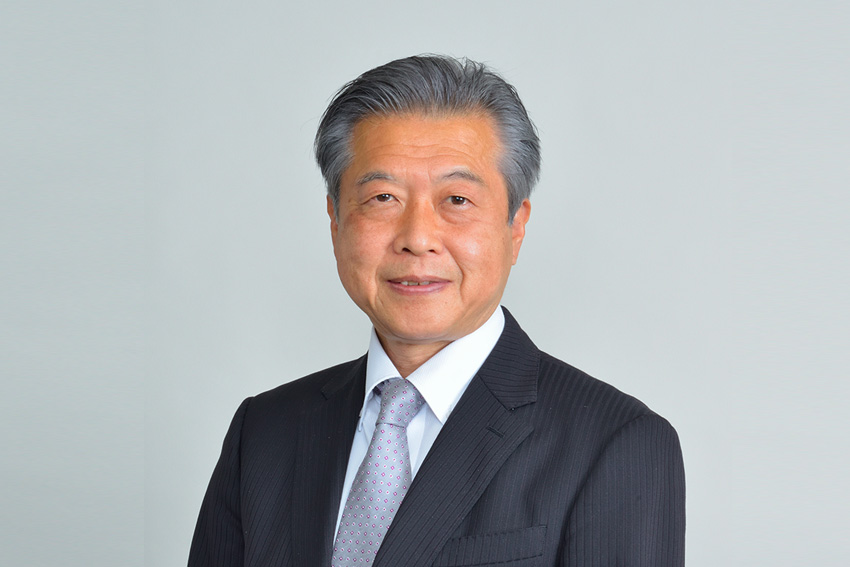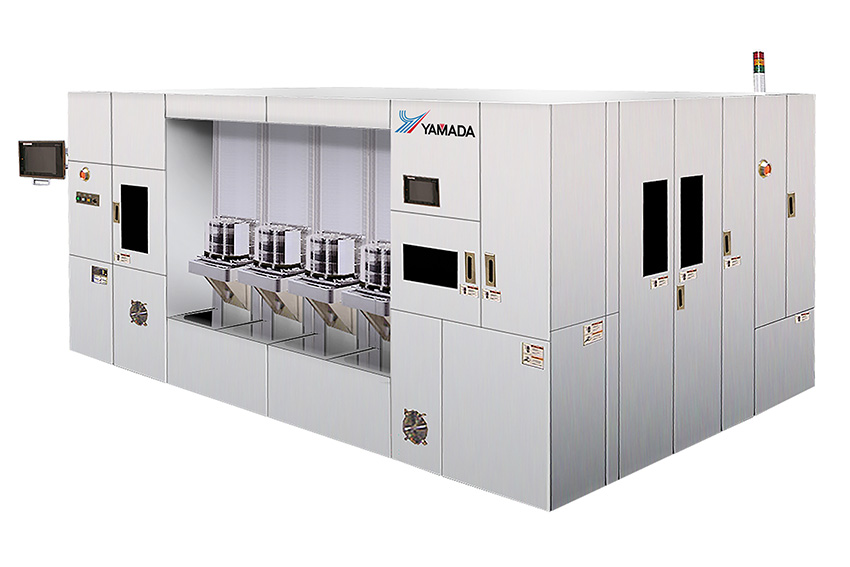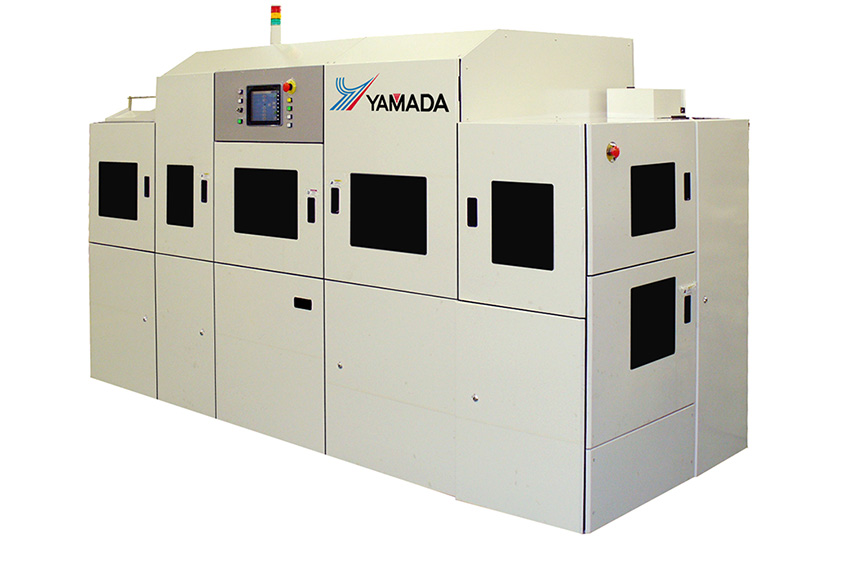The interview discusses the current state and future of Japan's manufacturing industry, emphasizing the need for diversification and high-value-added production to counter competition from China and South Korea. Innovations in the semiconductor industry, driven by AI, IoT, and other technologies, are highlighted, with specific attention to advanced packaging solutions and automation. Companies are looking to expand globally, particularly in North America and Asia, leveraging partnerships and the reputation of parent companies like Yamaha Robotics.

Japan's manufacturing industry is now at a critical juncture. Policies such as the U.S. Inflation Control Act are forcing companies to diversify their supply chains in terms of reliability, and also to mitigate country risks such as China. Japan is known for its reliability and advanced technology, and observers believe this is a unique opportunity now that the yen is weak. However, Japan faces stiff price competition from neighboring countries such as China and South Korea. What are your thoughts on the advantages of Japanese manufacturers in the current macroeconomic environment and how they can weather this price competition?
Most Japanese companies experienced hardship during the Lehman Shock, which triggered the global financial crisis. In the aftermath, Japanese companies lost the advantages they had cultivated and were unable to compete with Chinese and Korean companies in terms of prices. It was especially difficult to come up with solutions for consumer products such as electronics and raw materials. When they tried to go beyond the boundaries of the Japanese market, it became almost impossible for them to withstand the severe price competition in these areas.
To cope with this intense price competition, Japanese companies have focused on parts and equipment businesses in search of higher added value. Japanese companies are eager to come up with high-end technological solutions, focusing on efficiency and automation. They do this through diversification of their product lineups or technological upgrades to existing equipment. This is why Japanese companies can create unique products in B2B fields. It is also the strength of Japanese companies today that saved many of them in the difficult times following the Lehman Shock.
In our case, we are dealing with high-end products in semiconductor manufacturing equipment. To meet the needs of the market, we must supply our customers with top-notch products. This is a major reason why we overcame hard times and have become where we are today.
Japan’s demographic situation is a major issue that Japan is facing today. In the next 15 years, one-third of Japan’s population will be over the age of 60. This could lead to a labor shortage as well as a shrinking domestic market. On the other hand, however, this also creates opportunities such as the increased production of automation technology and equipment used in industries such as semiconductors. For Apic Yamada in particular, what are some of the challenges and opportunities this demographic shift is presenting to your firm, and how are you reacting to them?
This demographic shift poses a challenge to us all. Labor shortages are now a problem not only for our company but for the entire industry here in Japan. Finding and retaining qualified employees is a major issue. To overcome this challenge, we have taken steps to develop a skilled workforce within our company. This has mitigated the effects of potential labor shortages. For a company like ours, it is crucial to develop human resources in-house to maximize the use of our human capital and improve the quality of our production using a variety of approaches. This is a necessary step we are taking to address this issue.
On the other hand, there are positive aspects to this situation. There have been several breakthroughs in the semiconductor business itself, presenting us with growth and innovation. Some very talented young people want to dedicate their lives to semiconductors. Training these individuals along with our experienced senior employees has created a positive synergy within the company. We hope to take advantage of these demographics as we tackle our challenges. In the semiconductor business, we expect further breakthroughs. New emerging technologies such as automation, AI, and IoT are booming right now. Developing human capital will lead to new solutions to meet customer needs. Thus, we are also seeing the benefits of Japan's demographics.
As you have mentioned, we are seeing many innovations right now in the semiconductor industry. Applications such as AI, 5G, and code computing are driving the industry to become a USD 1 trillion industry by the end of the decade. Despite challenges such as inventory surges and the increased demand for monetary tightening last year, reports show that major foundries experienced revenue and profitability increases with the WSTS forecasting a 13% market size expansion in 2024. How do you foresee the need for semiconductor manufacturing in the ever-evolving landscape of the semiconductor industry?
Many new solutions are being developed in the semiconductor field, including the use of AI in production as well as HPC. These new solutions are escalating. There are also examples of miniaturization and combinations of different components, with giants such as TSMC and Nvidia leading the way. However, packaging the new kinds of chips that are being developed is a major problem that these companies are trying to solve. We are helping to solve this problem.
As you noted, the industry is now scaling up due to these new trends. Currently, orders for equipment for the advanced package are full. We are a group company. Shinkawa Ltd. is also a group company. They are in charge of FCB, and we are in charge of molding machines and dies, which are indispensable equipment for semiconductor manufacturing.
Our company is renowned for its advanced packaging technologies. The demand for smaller devices and power saving is increasing, and advanced packaging technologies such as 3D packaging and fan-out wafer level packaging (FOWLP) are expected to gain traction. We believe that our packaging technologies and solutions will become more important soon.
You have explained how the semiconductor industry has been influenced by AI, HPC, IoT, and other innovative technologies. In the future, ten years from now, what innovation do you believe will take over the semiconductor industry? What do you believe is next for the industry?
The entire ecosystem is developing rapidly. Our equipment is used to some extent in EV manufacturing and the automotive industry, but our main business is packaging equipment for semiconductor manufacturing. A lot is happening right now, so it is difficult to predict what will happen in the next 10 years. However, heterogeneous integration, advanced packaging technologies, and AI manufacturing will lead the industry. In the past year alone, there have been many changes in the industry. What is certain, however, is that the core technologies in use today will not change dramatically, as they are already top-notch when it comes to high efficiency and high production accuracy. These technologies may be upgraded and semiconductor miniaturization may continue, but they will remain core technologies.
The industry itself is experiencing major changes. For example, there used to be laser disks, and people focused on the features and capacity of laser disk memory. Then the semiconductor manufacturing industry developed chips that were more compatible and had larger memory sizes. Upgrading these chips became the main focus of the industry. In our industry, the trend changes very quickly as solutions evolve. We now live in a rapidly changing world. The industry is undergoing a revolution and change is happening fast. Therefore, we need to brush up on our technology and ensure that we can meet the changing needs of our diverse industry. That is the key to staying competitive in a dynamic market environment.
One of your products that we found interesting was your WCM-330 which is an automatic comprehensive molding system designed with Fan-Out wafer-level packages, Fan-In wafer-level packages, and Embedded Wafer wafer-level packages. Can you tell us how the WCM-330 ensures high-quality and high-speed packaging?

WCM-330
Our molding systems are fully automated with precision platen alignment and molding press supports for liquid and granular resins. An automated inspection system is also incorporated. Compared to conventional automated molding systems, this equipment is of a higher level. Accurate platen alignment, resin capacity, and support for different resin materials ensure high-quality, high-speed wafer-level packaging. Automated operation, optimized speed, and throughput attract many customers. We offer this as a fully automated, full-time solution. It can also be selected on a unit-by-unit basis.
The WCM-330 is designed to handle both liquid and granular resin materials, allowing for flexible molding to meet specific customer requirements. The press function of this machine can apply sufficient pressure with servo motors installed in the system. As a result, resin granules can be encapsulated reliably, improving work efficiency and quality. The press is an 85-ton press with a diameter of 300 mm and a TTV of 10 µm. Because it operates in a complete vacuum, the machine provides flexibility in the molding process based on the different requirements of the package design. This allows us to offer a variety of solutions tailored to our customer's needs.
You mentioned that companies should work with your product due to it being fully automated. Have your competitors not been able to automate the process, and how were you able to achieve this automation?
Other companies also have fully automated molding machinery for semiconductor manufacturing. However, we can provide more options than our competitors. We have attachments and many other solutions that our customers can choose from. That gives us an advantage. We also do not only provide our machinery to the customers but also be able to suggest optimum processes and materials.
Another one of your products that stood out was the Combo-300SW trim and form system which offers enhanced productivity and the ability to handle larger frames as well as a continuous molding cycle of 140spm. How does this system manage to shoot count for each die and what role does this feature play in ensuring process control and quality assurance?

Combo-300SW
This technology is now widely used in our portfolio of customers in the automotive industry. We introduced this technology decades ago and have provided upgrades and new solutions over the years. It is a trim-and-form system that manages the shot count for each mold through a control system with advanced sensor technology. It can cut lead frames and improve frame positioning. This product is in high demand in the automotive industry, a particularly demanding and highly sophisticated industry.
On top of the machinery that we have discussed, we also saw that you debuted a new machine, the MS-R series, in 2024. Are you currently looking to make more innovations, and if you are, what future innovations would you like to share with our readers?
The automotive industry is booming right now, with many new requirements related to EVs and inverters. More and more solutions are required for production sites. We want to promote and introduce different machine solutions to address this aspect of the automotive industry. That is one of the reasons why we are upgrading our machines to meet the evolving needs of each industry.
One technology that your company is famous for is your FAME technology which has received acclaim globally as it represents a breakthrough in molding technology. Could you elaborate more on this FAME technology, its uniqueness, and what types of solutions it provides to your customers?
FAME stands for Film Assist Molding Equipment, which was revolutionary in the industry when it was introduced in the 1990s. Now it is open to the public for research and can be used freely. We try to base our production on the needs of each industry. The semiconductor and automotive industries have come to us with highly sophisticated needs. We want to maintain and upgrade our technology to meet the evolving needs of our customers.
Throughout the creation of this report, we have interviewed many companies related to your industry. To meet the evolving needs of the semiconductor and automotive sectors, these companies told us that regardless of the size of the company, it is important to collaborate with partners especially in the overseas markets, whether that be North America, Germany, or China for example. Sharing know-how and penetrating new markets is crucial for a company to survive in this highly competitive field. In your specific case, are you looking to find these types of partnerships in the overseas markets, and if yes, which regions and what types of partnerships are you looking for?
We are a wholly-owned subsidiary of Yamaha Robotics Holdings Co., Ltd. This gives us access to sales channels and resources, as well as technical synergies with our parent company. The Yamaha brand is widely known overseas. We want to take advantage of the parent company's experience. As you mentioned, tie-ups are necessary in the semiconductor industry, and alliances and technical tie-ups with local companies are common. We want to introduce our machinery and molding technology overseas and to do so, we would like to partner with local players and/or utilize the achievements of our parent company.
You do not only offer your products to the domestic market in Japan. You also have overseas bases including your Apic Yamada America Office, Apic Yamada Taiwan Liaison Office, and Apic Yamada German Liaison Office. Which overseas region do you think has the most profit potential from a business perspective?
We have a presence in several regions. The first market we want to focus on is North America. This is because many large companies are expanding into North America. We want to improve our sales and maintenance services there, so we are sending representatives to the US to improve the quality of our work and to provide better solutions to our existing local customers. We work within Yamaha's facilities in the U.S. and our primary focus is in that region. Taiwan is another region we want to focus on, and we have a lab with an R&D center attached to our sales base in Taiwan. This serves as a hub for our activities in the Southeast Asian region. We also have a sales base in China that has a laboratory and we work with them in the Chinese market. Finally, we have Germany. In Germany, there are major developments in the automotive industry.
You became president of this company one year ago, and this year, the company is celebrating its 71st anniversary. Imagine that we come back four years from now for your 5th anniversary as president and the 75th anniversary of the company. What would you like to tell us? What dreams and goals would you like to achieve in the next four years?
Our history is closely related to Yamaha Motor Co., Ltd., as we are a member of the Yamaha Group. Yamaha has its unique strategy regarding overseas locations and markets, and it is important that our future incorporate that strategy. Yamaha Robotics Holdings Co., Ltd. is a world-renowned company and has many overseas customers. We intend to incorporate the corporate ethos of the Yamaha Group into our future business development and strategies.
Having Yamaha Robotics Holdings Co., Ltd. as our parent company has improved our operational efficiency and enhanced our brand reputation. Yamaha Robotics has many customers with sophisticated needs in line with the development of semiconductor manufacturing equipment. Yamaha Robotics is looking forward to providing solutions to existing and new customers by taking advantage of its features and technical know-how.
We want our employees to be happy working for our company. We want to see smiles at work and we want them to be happy with the work they do for our company. We had a welcome party for new employees this morning. (*date of interview: April 1st, 2024) I hope they will work for us for a long time. A company's human resources are critical to the success of the company. I want to focus more on the human aspect of my employees so that they are happy and motivated. That is my goal for the future.
0 COMMENTS